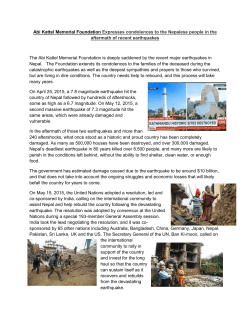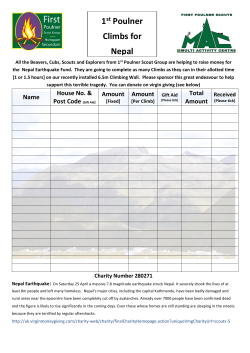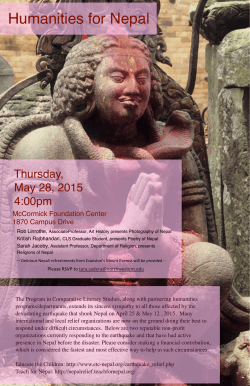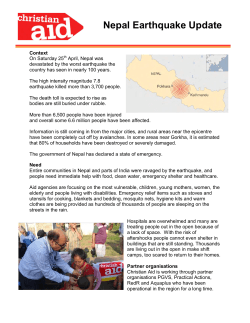
Magnitude 7.8 earthquake Nepal
Magnitude 7.8 earthquake Nepal Saturday, 25 April, 2015 at 06:11:26 UTC A magnitude 7.8 earthquake occurred 80 km to the northwest of the Nepalese capital, Kathmandu on 25th April 2015. This earthquake is the largest to have hit the Nepal region in over 80 years. The strongest shaking was felt by people living in surrounding towns and villages within 100 km of the epicentre, but significant shaking was felt up to 250 km away. Current esGmates suggest there are around 4,000 fataliGes. Damage and loss of life has also been caused by secondary effects such as landslides and mountain avalanches. The earthquake was caused by the ongoing collision between the Indian and Eurasian tectonic plates. Magnitude 7.8 earthquake Nepal Saturday, 25 April, 2015 at 06:11:26 UTC What are the likely impacts of the earthquake? Fatalities and damage Red alert for shaking-related fatalities and economic losses. High casualties and extensive damage are probable and the disaster is likely widespread. Shaking intensified by thick sediments in the Kathmandu Valley. Estimated economic loss Estimated economic losses may exceed the GDP of Nepal. Type of building structures in the area Overall, the population in this region resides in structures that are highly vulnerable to earthquake shaking, though some resistant structures exist. The predominant vulnerable building types are unreinforced brick masonry and rubble/field stone masonry construction. Secondary hazards Recent earthquakes in this area have caused secondary hazards such as landslides and liquefaction that might have contributed to losses. USGS PAGER hazard assessment Magnitude 7.8 earthquake Nepal Saturday, 25 April, 2015 at 06:11:26 UTC Where was the earthquake felt? Very strong (VII) to violent (IX) shaking was likely felt within ~125 km of the earthquake’s epicentre. This radius includes the Nepalese capital, Kathmandu, and Pokhara, the country’s second largest city. Nearly 10,000 people are esGmated to have been exposed to DestrucGve (VIII) or Violent (IX) shaking. Strong shaking also likely affected the India-‐Nepal border region, as well as southern Tibet (China). Predicted ground shaking intensity (image courtesy USGS) I. Instrumental Not felt by many people unless in favourable conditions. II. Weak Felt only by a few people at best, especially on the upper floors of buildings. Delicately suspended objects may swing. III. Slight Felt quite noticeably by people indoors, especially on the upper floors of buildings. Many to do not recognise it as an earthquake. Standing motor cars may rock slightly. Vibration similar to the passing of a truck. Duration estimated. IV. Moderate Felt indoors by many people, outdoors by a few people during the day. At night, some awakened. V. Rather Strong Felt outside by most, may not be felt by some people in non-favourable conditions. Dishes and windows may break and large bells will ring. Vibrations like train passing close to house. VI. Strong Felt by all; many frightened and run outdoors, walk unsteadily. Windows, dishes, glassware broken; books fall off shelves; some heavy furniture moved or overturned; a few instances of fallen plaster. Damage slight. VII. Very Strong Difficult to stand; furniture broken; damage negligible in building of good design and construction; slight to moderate in well-built ordinary structures; considerable damage in poorly built or badly designed structures; some chimneys broken. Noticed by people driving motor cars. VIII. Destructive Damage slight in specially designed structures; considerable in ordinary substantial buildings with partial collapse. Damage great in poorly built structures. Fall of chimneys, factory stacks, columns, monuments, walls. Heavy furniture moved. IX. Violent General panic; damage considerable in poorly designed structures, well designed frame structures thrown out of plumb. Damage great in substantial buildings, with partial collapse. Buildings shifted off foundations. X. Intense Some well build wooden structures destroyed; most masonry and frame structures destroyed with foundation. Rails bent. XI. Extreme Few, if any masonry structures remain standing. Bridges destroyed. Rails bent greatly. XII. Cataclysmic Total destruction – everything is destroyed. Lines of sight and level distorted. Objects thrown into the air. The ground moves in waves or ripples. Large amounts of rock move position. Landscape altered, or leveled by several meters. In some cases, even the routes of rivers are changed. Modified Mercalli Intensity Scale Magnitude 7.8 earthquake Nepal Saturday, 25 April, 2015 at 06:11:26 UTC Past earthquakes in the region The Himalayas are a very tectonically acGve part of the world. This means that earthquakes are not uncommon, with several earthquakes that are large enough to be felt occurring every year. Large earthquakes are however more rare. The last massive earthquake to occur in this area was the M 8.2 Nepal-‐Bihar earthquake that happened in January 1934. This earthquake caused widespread devastaGon, and fla_ened several towns in Nepal and India. It is worth noGng that all of the earthquakes in this are relaGvely shallow, with almost all being at less than 33 km depth. This is one of the reasons why the April 2015 earthquake has caused so much damage and loss of life. M8.2, Jan 1934 Map showing all events of magnitude greater than M 6.5 that have occurred in the area since 1900. The location of the April 2015 earthquake is indicated by the red star. Earthquake data courtesy of the USGS and map data courtesy of Google Earth. Magnitude 7.8 earthquake Nepal Saturday, 25 April, 2015 at 06:11:26 UTC What caused this earthquake to occur? At the locaGon of this earthquake, the India plate is underthrusGng beneath the Eurasia plate at a rate of about 45 mm per yr. This make the region one of the most seismically hazardous on Earth. A series of thrust faults parGally accommodate this convergence. According to the preliminary locaGon, size and focal mechanism, the April 25, 2015 M 7.8 Nepal earthquake occurred as a result of thrust faulGng on or near the main Himalayan frontal thrust between the India plate and the overriding Eurasia plate to the north. Indian plate Simple block model showing the direction of motion across a thrust fault Focal mechanism of the Nepal earthquake showing thrusting (from the USGS) Eurasian plate Eurasia plate Cartoon cross-section illustrating the collision between the Indian and Eurasian plates and the likely location of the 2015 earthquake. India plate Map showing the location of the Himalayan thrust plate boundary fault 45 mm/yr Magnitude 7.8 earthquake Nepal Saturday, 25 April, 2015 at 06:11:26 UTC Recordings of the earthquake from the British Geological Survey seismometer network These seismometers are located some 7000 km (4500 miles) from the earthquake’s epicentre. The P-‐waves are the first to arrive, but the later-‐arriving surface waves have the strongest amplitude. Plot similar seismograms yourself at: http://ds.iris.edu/wilber3/find_stations/5111620 Magnitude 7.8 earthquake Nepal Saturday, 25 April, 2015 at 06:11:26 UTC Aftershocks As with any significant earthquake, aaershocks are expected. At the Gme of wriGng (27/04/15), nearly 60 aaershocks have been recorded by the USGS. M6.6 M6.7 The largest recorded aaershocks have been M6.6 and M6.7 events, 40 minutes and 1 day aaer the mainshock, respecGvely. InteresGngly, most aaershocks are located to the southeast of the mainshock hypocentre. This indicates that the rupture may have travelled a south-‐easterly direcGon during the mainshock. Map showing all aftershocks with magnitude greater than 4 recorded by the USGS. The mainshock location is given by the red star. Earthquake data courtesy of the USGS. Magnitude 7.8 earthquake Nepal Saturday, 25 April, 2015 at 06:11:26 UTC Find out more … • USGS webpage for this earthquake http://earthquake.usgs.gov/earthquakes/eventpage/us20002926#general_summary • BGS (British Geological Survey) – seismology and earthquakes – frequently asked questions http://www.earthquakes.bgs.ac.uk/education/faqs/faq_index.html • BBC News article on this earthquake http://www.bbc.co.uk/news/science-environment-32462763 • IRIS special event page http://ds.iris.edu/ds/nodes/dmc/specialevents/2015/04/25/nepal/ • IRIS (Incorporated Research Institutions for Seismology) – learning about earthquakes http://www.iris.edu/hq/programs/education_and_outreach/students • UK School Seismology Project – classroom activities, videos and support documents http://www.bgs.ac.uk/schoolseismology/home.html • USGS (United States Geological Survey) – FAQs, glossary, posters, animations http://earthquake.usgs.gov/learn/ • EMSC (European Mediterranean Seismological Centre) http://www.emsc-csem.org/
© Copyright 2025









